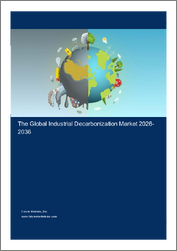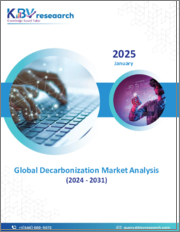
|
시장보고서
상품코드
1599146
화학 산업의 탈탄소화(2024년)Decarbonizing the Chemical Industry - 2024 |
||||||
화학 산업은 전체 배출량의 약 2%를 차지하는 산업계의 가장 큰 에너지 소비자입니다. 이 부문의 탄소 배출은 화학 반응에 필요한 공정 에너지와 화석 연료를 원료로 사용하는 과정에서 발생합니다.
이 보고서는 이 부문의 배출 발자국을 개선하기 위한 4가지 주요 방법론으로 공정 효율 향상 및 전기화, 그린 수소, CCUS, 바이오매스 및 폐기물 기반 원료 등을 꼽았습니다. 이 네 가지 방안은 이 부문의 공정 에너지 및 원료 요구 사항을 해결하기 위한 것입니다.
이 보고서에서 확인된 에너지 전환 기술 개입 방안은 단기적인 배출량 감축과 장기적인 배출량 감축을 제공하는 전략으로 나눌 수 있습니다. 단기적 배출량 감축은 공정 효율을 개선하여 에너지 수요를 줄이는 데 초점을 맞추고 있습니다. 이 보고서는 AI, IoT, 디지털 트윈의 적용을 통해 장비의 비효율성을 파악하고 화학 플랜트 운영을 최적화하는 데 어떻게 활용할 수 있는지를 설명합니다.
그러나 장기적으로는 생산과 배출을 분리해야 하며, 이를 위해 산업계는 탄소와의 관계를 극적으로 변화시켜야 하며, CCUS 개조는 공장에서 배출을 피하기 위해 사용할 수 있지만, 이 기술은 더 넓은 CCUS 운송 및 저장 인프라의 출현을 전제로 합니다. 한편, 그린 수소, 바이오매스 및 플라스틱 폐기물은 모두 이 부문의 원료인 화석 연료에 대한 의존도를 낮추기 위해 사용할 수 있는 대안이 될 수 있습니다.
주요 하이라이트
- 모든 주요 화학제품은 수요 증가에 따라 생산량이 증가할 것으로 예상됩니다. 폴리프로필렌과 폴리에틸렌의 생산량은 2024-2030년 각각 연평균 3.8%, 2.8% 성장할 것으로 예상됩니다.
- 한편, 암모니아와 같은 주요 제품은 같은 기간 동안 1.7%의 성장을 보일 것으로 예상됩니다. 그러나 암모니아 생산의 탄소 강도는 암모니아 생산의 이 작은 증가가 더 넓은 산업의 배출 발자국에 큰 영향을 미칠 것이며, 암모니아만 화학 부문 배출량의 45%를 차지할 것으로 예상됩니다.
- 기술 혁신은 화학 생산과 에너지 수요의 분리를 촉진하고 단기적인 배출량 감축의 열쇠가 될 수 있습니다.
- 공정 에너지 요구량을 줄이는 새로운 촉매 개발 및 에너지 회수 방안은 화학 부문의 에너지 수요를 줄이고 폐기물을 방지하는 열쇠가 될 수 있습니다.
- 농작물이나 폐기물과 같은 생물 유래 원료를 활용하여 원료를 다양화하면 화석연료 의존도를 줄일 수 있는 길이 열립니다. 또한, 플라스틱 폐기물은 열분해 등의 공정을 통해 새로운 화학제품 원료로 재활용할 수 있습니다.
- 산업용 에너지 수요는 2024-2035년 기간 동안 연평균 7%의 성장률로 강력하게 증가할 것으로 예상됩니다. 이러한 성장으로 인해 전 세계 전력 수요에서 산업 부문이 차지하는 비중은 2024-2035년 2.4% 증가할 것으로 예상됩니다.
이 보고서는 세계 화학 산업에 대한 조사 및 분석을 통해 시장 동향, 주요 기업의 배출 감축 활동 평가, 주요 탈탄소화 기술에 대한 인사이트, 저탄소 기술 채택 동향 등의 정보를 제공합니다.
목차
- 주요 요약
- 탄소 배출과 거시적 전망
- 화학 산업의 기후변화에 대한 기여
- 주요 화학제품 수요
- 암모니아의 화학제품 배출에 대한 기여
- 탈탄소화 기술의 도입
- 화학제품용 4개 주요 탈탄소화 기술
- 기술 : 탈탄소화 가능성별, 단계별
- 탈탄소화 기술의 장단점
- 탈탄소화의 장벽이 되는 거시경제적 과제
- 주요 기업의 목표와 배출
- 주요 화학·석유화학 기업의 배출과 넷제로 목표
- 프로세스 효율
- 화학 산업의 에너지 사용
- 프로세스 효율 향상에 이용하는 주요 방법
- 프로세스 효율 사례 연구
- 화학제품의 수소
- 저탄소 수소 최종 용도로서의 화학제품
- 저탄소 암모니아 생산
- 화학 부문을 타겟으로 한 저탄소 수소 프로젝트
- 사례 연구
- 화학제품의 CCUS
- CCUS 처리 능력 전망
- 프로젝트와 사례 연구
- 원료로서의 바이오매스와 폐기물
- 바이오매스 기반 화학제품
- 폐플라스틱 기반 화학제품
- 문의
The chemicals industry accounts for approximately 2% of emissions and is the largest industrial energy consumer. The sector's carbon emissions stem from the combination of process energy which is required for chemical reactions as well as the use of fossil fuels as a feedstock. This report identifies four key methodologies for improving the sector's emissions footprint: increasing process efficiency and electrification, green hydrogen, CCUS, and biomass and waste-based feedstocks. These four measures address the sector's process energy and feedstock requirements.
The energy transition technology interventions identified within this report can also be broken down into strategies that provide near-term and long-term emission reduction. Shorter-term emission reduction will focus on reducing energy demand through increasing process efficiency. This report outlines how applications of artificial intelligence, Internet of Things (IoT), and digital twins can be used to identify equipment inefficiencies and optimize chemical plant operations.
However, in the longer term, there is a need to decouple production from emissions, which will require the industry to dramatically shift its relationship with carbon. CCUS retrofits can be used to avert emissions from plants, but this technology is contingent on the emergence of a wider CCUS transport and storage infrastructure. Meanwhile, green hydrogen, biomass and plastic waste all represent alternatives that can be used to reduce the sector's reliance on fossil fuels for feedstock.
Key Highlights
- All major chemical products are expected to experience an increase in production in response to increasing demand. Polypropylene and polyethylene are forecast to experience a growth in production of CAGR 3.8% and 2.8%, respectively, between 2024 and 2030.
- Meanwhile major products such as ammonia will experience a slower growth of 1.7% across the same time frame. However, the carbon intensity of ammonia production will cause this small increases to have a significant impact on the emission footprint of the wider industry, with ammonia alone accounting for 45% of the chemical sector's emissions.
- Technological innovation will facilitate a decoupling between chemical production and energy demand, which will be key to short-term emission reductions.
- Developing novel catalysts that reduce process energy requirements and energy recovery measures will be key to cutting the sector's energy demand and preventing waste.
- Diversifying feedstocks by using biogenic materials such as crops and waste products offers a route to decreasing reliance on fossil fuels. In addition, plastic waste can be recycled into new chemical product feedstock through processes such as pyrolysis.
- Industrial energy demand is expected to increase strongly between 2024 and 2035, growing at CAGR of 7% across the time frame. As a result of this growth, the industrial sector will hold an increasing proportion of global power demand, with its share rising by 2.4% between 2024 and 2035.
Scope
- Chemical sector emissions, key chemical companies emission disclosure, chemical decarbonization strategies, low-carbon hydrogen, CCUS, increasing efficiency, alternative waste and biomass-based feedstocks.
Reasons to Buy
- Identify the market trends within the industry and assess what the biggest players in chemical production are doing to reduce emissions.
- Develop market insight of the major technologies used to decarbonize chemical production through case studies from industry leaders.
- Understand the chemical industry adoption trends of emerging low-carbon technologies such as hydrogen and CCUS.
Table of Contents
Table of Contents
- Executive summary
- Carbon emissions and macro-outlook
- Chemicals industry's contribution to climate change
- Demand for major chemical products
- Ammonia's contribution to chemical emissions
- Introduction to decarbonization technologies
- Four key decarbonisation technologies for chemicals
- Technologies by decarbonization potential and stage
- Advantages and disadvantages of decarbonization technologies
- Macroeconomic challenges that will pose a barrier to decarbonization
- Key player targets and emissions
- Emissions and net-zero targets of key chemical and petrochemical players
- Process efficiency
- Energy use in the chemicals industry
- Key methods for increasing process efficiency
- Process efficiency case studies
- Hydrogen in chemicals
- Chemicals as an end-use sector for low-carbon hydrogen
- Low carbon ammonia production
- Low-carbon hydrogen projects that will target the chemical sector
- Case Studies
- CCUS in chemicals
- CCUS capacity outlook
- Projects and Case Studies
- Biomass and waste as feedstocks
- Biomass-based chemicals
- Waste plastic-based chemicals
- Contact us



















